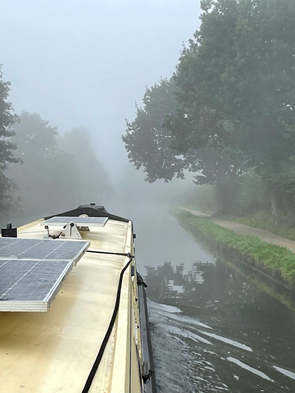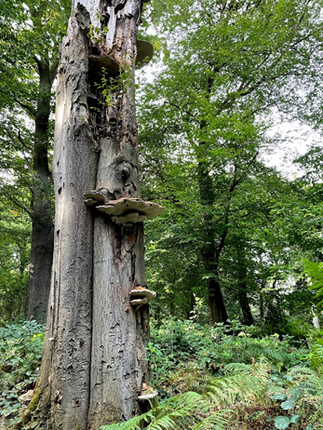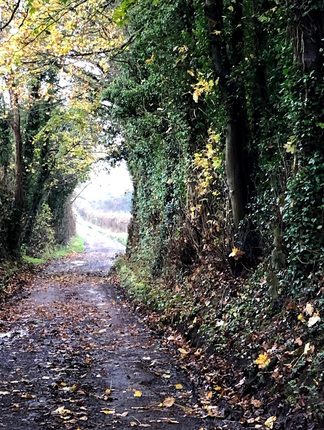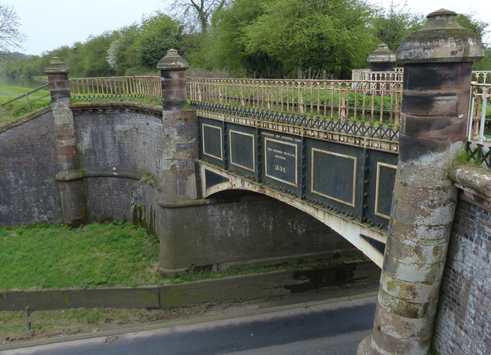Dear Motley Crew,

So, here She was then, just where we’d left her, and waiting, somewhat impatiently it must be said, for a resumption of our adventures.
“So, how was Paris?” She asked. “Oh, you know,” we demurred. “You didn’t miss much.”
Well, what could we say?
We took a day or two to settle and to get our affairs in order, and then we were off, heading back along the Leeds and Liverpool canal towards Manchester, and then, ultimately, south towards Blisworth.
Over the past two years, we have begun each stage of our travels with a variety of emotions – nervousness, excitement, and anticipation - but never before had we set out with a sense of sadness. But such was the sentiment felt presently, for the journey upon which we were now embarking, dear Motley Crew, was to be our swansong, our final adventure with Matanuska. It was, however, not something that we were discussing within her hearing.
In the short space of time in which we’d been away from the canals, subtle changes had begun. The mornings, we noticed, were now a touch cooler, and darker, and it was becoming necessary to use the lights inside of an evening. Changes were also becoming evident in the foliage along the towpath, and the surface of the water now had a light scattering of fallen leaves.
As the miles slipped away behind us, the predominantly rural landscape of Lancashire began to give way to the urban.

Ah, the Blackburn flight – some things hadn’t changed in our absence. Or had they? Was it possible that it was, in fact, even worse than when we’d last passed through?
Thirty-six locks ahead of us soon became thirty-six locks behind us, and it was with some relief that we re- joined the lockless Bridgewater Canal, and paused to catch our breath.

“Ah, the Bridgewater”, She purred, “and Worsley, I think. Remember?” We did. Worsley, you may recall, was the scene of our previous awkward encounter with the Packet House’s front lawn. On that occasion, we had been so focused on extracting ourselves from the garden bed and attempting to minimise our ungainly manoeuvre, that we’d had little time to consider our surroundings. We had, therefore, failed to take suitable note of the twin tunnels tucked away behind these signs.

But on this return trip, we took the time to take note and discovered the extraordinary history that lay within their depths.
It had all started with a coal mine that needed draining.
In 1757, the Duke of Bridgewater – the 3rd Duke no less – inherited the family’s coal mines that had been producing fitfully since the 1300’s.

It was time, he decided, to turn them into a commercially viable enterprise. But first, he needed to address a long-standing problem with drainage. Or rather, the lack of it.
In order to rid his mines of the excess water, the Duke commissioned a series of underground canals to be dug from the workings to The Delph, the basin behind those signs. Ultimately, these canals not only solved his drainage issues, but they also did service as a means of transporting the coal from the mines to the basin. Two for the price of one in effect.
However, the thing that I found to be the most extraordinary was, that the 46 miles of canals were constructed over four different levels, with each level connected to the others by a water-powered inclined plane and lift. Here’s how it functioned.
Purpose-built boats, known as starvationers, were used to transport the coal down through the levels to the lowest level, and from there they were “legged” onto the canal.

Not a job for the faint-hearted or a claustrophobic I’d imagine

What a spectacular and elegant feat of engineering
We pushed on now through misty mornings,
and moored up to take in startling sunsets.

We took the time to explore the woods alongside the canal with, it must be said, a feeling of nostalgia, knowing that our next autumn will not look like this.
Back on the canal, we were approaching a junction – one that would require a decision to be made.

Continuing on ahead would take us back along waterways explored last year – familiar territory. A right-hand turn, by contrast, would offer the opportunity to explore new towns and villages, a pull, in the end, too strong to resist. A right-hand turn would also take us onto the Shropshire Union Canal, the first canal that we had first explored all those years ago – the one that had resulted in us being where we were. It felt only right and proper then, that on our last foray along the canals, we should turn to starboard.
This decision had a serendipitous outcome, for it led us to a small village with strong links to Australia.
In the graveyard at St Mary’s church in Acton, lie the remains of one Albert Neilson Hornby. In 1882, it was Hornby who captained England against Australia in a Test match that resulted in England’s loss by seven runs. An “obituary” printed in the Times on the following day, and the following cremation of the bails purportedly used in that match resulted in the creation of the Ashes series.
The decision to travel back along the Shropshire Union canal also afforded us the opportunity to re-visit some of our favourite haunts, in particular, the town of Nantwich. Charged as having one of the county's largest collections of historic buildings, second only to Chester, Nantwich demands that you explore it at leisure.

These had us tossed. Used they lead to a now blocked-off doorway? The width of the building seemed to suggest not.
A little sleuthing revealed that they were mounting blocks, an aid for clambering aboard your steed with some decorum
But to be honest, dear Motley Crew, our main purpose in returning to Nantwich had more to do with weaseling than culture.
In 2018, we had, on a narrow-boating holiday, visited Nantwich with the Cook and the Storeman, and, on that occasion, we partook of afternoon tea at Ginger and Pickles, purveyor of fine cakes and refreshments. They had served us bara brith, a traditional Welsh tea-bread, flavoured with tea, dried fruits and spices, and The Cook, who was soon swooning over the delicacy, had done all she could to wheedle the list of ingredients out of the staff, even promising to take the secret recipe to her grave.
All to no avail. Their lips were sealed. And so, we were here to see if we could succeed where she had failed.
We also failed. It seemed that no amount of swooning, wheedling, weaseling or pleading would persuade them to part with the recipe, and we came away, again, with full bellies and little else.

Further along the canal, at Hack Green, we noted that the Ministry of Defence could well have learned a thing or two from the staff at Ginger and Pickles
A run of locks now stretched ahead – 15 in the first flight, then two sets of five. Although 25 locks in a day make for a long day, it was not so much the total number of locks that was our concern, but rather just one in particular. Tyrley Bottom Lock has a fearsome reputation, well deserved. The bywash, a channel for excess water that runs alongside many locks, delivers, at this lock, a formidable stream of roaring, churning water into the pound.

Descending boats have to steer into it at speed, to prevent themselves from being slammed up against the rock wall on the opposite side.

Ascending boats have a more difficult task, having to negotiate the surge whilst navigating their craft into the lock. Too much throttle and you slam into the lock wall; too little, and you are caught by the surge and pushed off course, and sideways into the rocks. Full marks to the Captain, as we made it into the lock with only the slightest connection with the lock wall.

Such an idyllic looking scene but so deceptive
The nature of the canal now began to change, and soon open fields and low bridges,
gave way to deep, fern-lined cuttings and soaring viaducts.
As late afternoon approached, the inclement weather that had dogged us all day began to close in behind. A dash over the Stretton Aqueduct – and Watling Street – and our goal, the terminus of the Shropshire Union canal was in our sights.
Hot showers, restorative whiskies and an early night were in order as tomorrow promised to be a long day. An early start would be required, for ahead of us lay the Wolverhampton 21.
The Captain, The Commodare, and a tired Mrs Chippy.





































































Welcome back, best one yet, or is it "distance/time make sthe heart .........."
The storeman laments the tight-lipped staff at the Ginger and Pickles, being unable to procure the ingredients to nourish the crew with the utter delight of Bara Brith throughout these meanderings. Reminded of his own meanderings along the Strophshire, the storeman is likewise saddened by this leaving and rather yearns for endless adventure along those waterways, perhaps til the end of days…….wistfully, the storeman
Correction of ‘were not wasted’ not ‘we not wasted’. Apologies from the Cook.
Greetings to the Captain and the Commodore.
References to times gone by in the Commodore’s last post, ‘Take the long way home’, we not wasted on the Cook. It remains to be seen if the Storeman observes wry mention of what one would miss if one bypasses beautiful sights in major French cities.
Congratulations to the Commodore on her stealth and the subsequent recording of the elusive English rodent. I live in hope that the equally elusive recipe of the Welsh fruit bread may one day, be mine. I thank you both for your reconnaissance and note regret that the Storeman and I were not available to accompany your return journey to Nantwich.
Your shared letters and photography has helped…